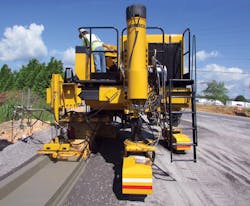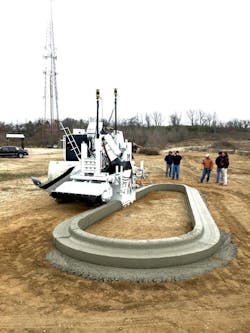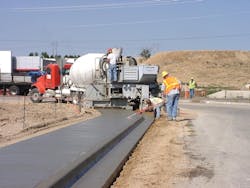Construction Equipment recently asked a number of slipform-paver manufacturers for their views on the state of the industry—machine development, market trends, user concerns, and new products recently released. The collective opinions of these experts provide both a window into this vital industry, as well as information that can assist buyers in making informed choices as they endeavor to get the most value from their concrete paving equipment investment.
Key trends in concrete paving machine design?
“Certainly one technical trend we’re seeing is design innovation that reduces the time to make paving-width changes. Our newest models, for example, have straddle legs, a design that significantly reduces change-over time.
Another trend is the shift to stringless concrete paving. For stringless paving to be successful, however, a contractor really needs someone in-house who understands the 3D model, can review it, say, for curb breaks, and make corrections before downloading to the machine. The in-house expert should also be able to walk the job with a rover and make sure all points are correct—catch basins, for instance. Significant labor savings result from not having to set a conventional line, but stringless paving does require an investment from the contractor, both for the technology and for a trained person who understands the technology.” Stephen Bullock, VP, sales & marketing, Power Curbers & Power Pavers
“Paving contractors today, more than ever before, want to be sure that newly purchased machines are as technically advanced as possible—ready to evolve as they do. They’re especially concerned with stringless technology, which is fairly widely used in mainline paving, but not quite as much for curb-and-gutter and barrier work so far. That said, we find that most customers considering a new machine want to be ready for stringless, but not all are willing to make the commitment, either because of the cost, or because they’re uncertain about how the technology works. We think that as more of this technology gets into the field, more contractors will be willing to make the transition.” Tod Smith, sales, Miller Formless
“The vision of stringless paving in our company goes back perhaps some 20 years, and we committed the resources to develop the technology. So while the concept isn’t really new for our customers, we think what’s becoming more important is to design machine control systems, such as our G+ system, to seamlessly integrate with all 3D guidance systems in order to give contractors a choice.” Kevin Klein, VP of engineering/research & development, GOMACO
“Market-leading paver design will first center around real intelligence in the control system. This speaks to a number of key areas: maneuverability; reduced set-up time; diagnostics; productivity; and not least of all, precision. Balance must also be struck with the paver design itself to enhance such characteristics as versatility and transportability, while reducing paving-width change times. To illustrate, our SP 60 series models have a modular frame design that allows for three-track off-set applications, as well as up to 25-foot mainline paving. The frame design allows users to go from a paving configuration to a transport configuration in less than 10 minutes without the mold or Super Smoother needing to be removed.” Tim Nash, director, concrete products, Wirtgen America
“We’re seeing a trend in technical advances in regard to machine control automation, which allows higher job-site efficiencies. While we still offer string and sensor options, we have advanced our technologies and developed options to include GNSS stringless paving.” Curtis Bales, business & sales manager, Easi-Pour
“We’re also seeing an increased demand for telematics and the capability to pour both left- or right-handed with the same machine. Traditionally, curb and barrier machines have been dedicated right- or left-hand pour configurations.” Tod Smith (Miller Formless)
“Telematics’ has become a buzz word in the industry, and manufacturers are working to incorporate that technology into their machines. We designed the GOMACO Remote Diagnostics system specifically for concrete pavers to expand on conventional telematics capability. Users have visibility into how, when, and where their equipment is being used, and remote capability allows diagnostic reviews—on site, in the shop, or at the factory—and also allows updating software and sending new code for 3D machine guidance directly to the project. The system also can actually read the smoothness of a newly paved slab. When the paver is equipped with the GOMACO Smoothness Indicator, contractors can access real-time smoothness performance on a mobile phone or a desk-top computer.” Kevin Klein (GOMACO)
“The concrete-paving market continually asks for versatility—versatility that includes quick loading/unloading capabilities and the ability to adapt to job-site conditions and perform applications well. To illustrate, our machines can naturally pour between the tracks, but if job-site conditions call for zero-track-line paving—for example, when pouring shoulders or outside lanes— then the machine can pour in what we call a ‘cantilever’ set-up with the mold offset to the side.” Kevin Klein (GOMACO)
What is the general state of health for the various slipform markets?
“Taking the long view, in general, the market in all slipform segments are up and customer order books look healthy through 2018.” Tim Nash (Wirtgen)
“We’ve been experiencing a significant upward trend in new [sales of concrete paving equipment] for residential and commercial curb-and-gutter segments of the market.” Curtis Bales (Easi-Pour)
“Our customers are doing very well right now, and there’s a lot of work underway. Many are looking to the future and updating older equipment. We’re seeing an increase in curb-and-gutter work in the Midwest, both residential and commercial. The barrier market seems strongest in the South right now, predominantly in Georgia, Florida, and the Carolinas. Our strategic alignment with Guntert & Zimmerman [formed Oct. 2016 to meld sales, marketing, and service divisions] also is yielding increased opportunities in international markets, which seem to be very good at present.” Tod Smith (Miller Formless)
“The curb-and-gutter/sidewalk market is quite strong domestically due to the increase in housing starts over the past couple years—and the commercial development that follows new houses. Global infrastructure investment also has created demand for slipform road-paving equipment.” Stephen Bullock (Power Pavers/Power Curbers)
What challenges are slipform contractors up against today?
“One area I think most contractors are facing a similar problem is that of finding and keeping skilled workers to run equipment. From a project-specific viewpoint, jobs tend to be cut-up, reconstruction-type work, which presents numerous challenges, including discontinuous paving runs, multiple width-change requirements, and simply getting concrete to the machines in the quantities needed—while at the same time addressing tighter smoothness specifications. This is precisely where we’ve focused paver design.” Tim Nash (Wirtgen)
“As in any construction segment, labor, not only skilled labor, but simply anyone willing to do physical work, is difficult for paving contractors to find right now. This situation, in part, is what’s driving the demand for stringless operation. In spite of the relatively high cost [of stringless systems], contractors are willing to make the investment, because of the difficulty of finding laborers willing to pound pins in the ground to set string line.” Stephen Bullock (Power Pavers/Power Curbers)
“Transportability and versatility are major challenges today. Not every concrete-paving contractor has the luxury of of doing long, wide, mainline paving with a large machine. So, the need today is for machines that can be loaded quickly, moved to different projects around the territory, unloaded, and then knock out a one-day pour. It’s not uncommon for a versatile slipform machine to be paving a city street today, and then to be clear across town the next day on another project. The paving season is short in many parts of the county, so the slipform paver needs the ability to change widths and setups in a reasonable amount of time. Kevin Klein (GOMACO)








